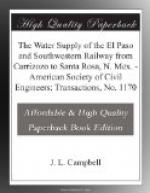The reduction from 7 to 3-1/2 in. at Mile 230 (Plate V) is on account of delivering water to the Santa Fe’s new transcontinental low-grade line which crosses the El Paso and Southwestern Railway at Vaughn, and has a division point there. On its adjacent divisions, the Santa Fe had the same trouble with local waters which compelled the El Paso and Southwestern to find a better supply. The Bonito water is conducted to and used at points 160 miles from its origin on Bonito Creek.
DISCUSSION
G.E.P. SMITH, ASSOC. M. AM. SOC. C.E. (by letter).—The author has done great service to the West in demonstrating the practicability of transporting small water supplies to great distances.
Close association with the desert is required to appreciate fully its waterless condition. For most of the year there are no living waters on the surface. As a rule, ground-waters are concentrated beneath very limited areas of valley land. The great masses of valley fill in some places are underdrained to great depths and in other places are so compacted and cemented as to be impervious. Wells sometimes are driven from 1,000 to 2,000 ft., without securing any supply at all. Moreover, desert ground-waters are often exceedingly hard or alkaline, and, therefore, are unfit for many uses.
In going to the high mountains for a supply, the author has struck a principle of wide application. In many of the mountains of the Southwest there are springs and small streams of excellent water. Often, as in the case discussed, very little storage is required. These streams, however, are absorbed or disappear before reaching even the mouths of the canons, and the problem has been to convey the water to distant cities and mining camps at reasonable cost. There are several cities in Arizona now possessing pumped water supplies, which have possible gravity supplies of superior quality. The writer believes that ultimately the gravity supplies will replace the pumping plants.
In the Bonita pipe line, wood-stave pipe was used for the gravity sections. In other localities, where the grade of the line is very uniform, as would be the case down a typical clinoplain, cement pipe is deserving of consideration. It would cost no more than wood stave, would be more durable, and, furthermore, it need have no greater leakage. Its cost, however, increases rapidly when built to withstand high pressures.
The use of bran for determining velocities is of interest. The results are in close accord with those obtained from the weir measurements. In the measurement of ground-water velocities by means of salts in solution, it is found that the velocities of different filaments of waters are extremely variable, and a quart of salt solution, after moving forward a few feet, is widely dispersed. It would be of value to know to what extent the bran was distributed during its 4-hour journey through the pipe line, and during how many minutes it was being discharged at the lower end of the line. Was the first appearance, or the average time of appearance, accepted for computing the velocity of flow?




